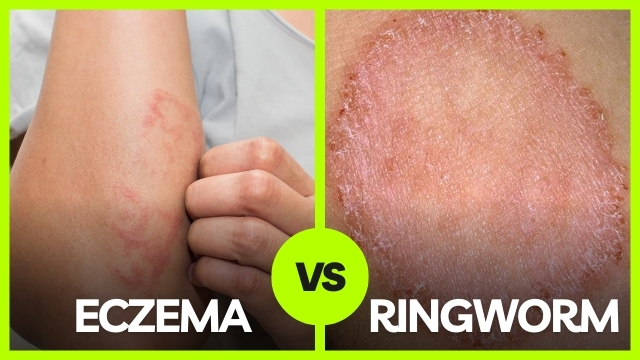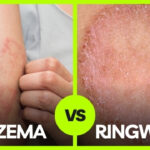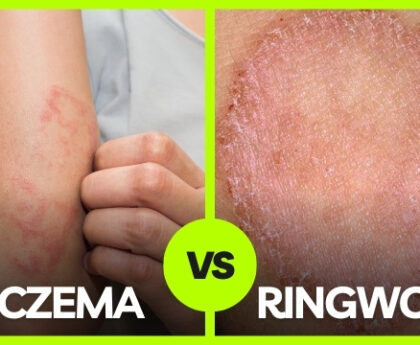Introduction
As a parent, navigating the world of skin conditions can be overwhelming, especially involving your child. Two common but often confusing conditions are ringworm and eczema. Understanding these conditions, how they differ, and how to manage them effectively can make a difference in your child’s comfort and health.
Understanding Ringworm
What is Ringworm?
Despite its name, ringworm isn’t caused by worms but is a fungal infection known as dermatophyte. It’s called “ringworm” because of the ring-like rash it often creates on the skin. This condition is highly contagious and can spread through direct contact with an infected person or animal or contaminated items like towels and bedding.
Causes of Ringworm
Ringworm is caused by several types of fungi, including Trichophyton, Microsporum, and Epidermophyton. These fungi thrive in warm, moist environments, so ringworms are common in locker rooms and public pools.
Symptoms of Ringworm
The primary symptom of ringworm is a red, itchy rash that typically starts as a small, flat, scaly spot and gradually expands into a ring-like shape. The center of the ring may appear clear or slightly scaly, while the edges are often raised and red.
How Ringworm Spreads
Ringworm spreads through direct skin-to-skin contact with an infected person or animal. It can also be contracted from contaminated objects like combs, brushes, and bedding. The fungi can live on surfaces for months, making hygiene and cleanliness crucial in preventing its spread.
Understanding Eczema
What is Eczema?
Eczema, or atopic dermatitis, is a chronic inflammatory skin condition. It causes the skin to become red, inflamed, and itchy. Eczema is often associated with other atopic conditions, such as asthma and hay fever; various factors, including allergens, irritants, and stress, can trigger it.
Causes of Eczema
The exact cause of eczema is unknown, but it is believed to result from genetic and environmental factors. A faulty immune system response and a weakened skin barrier that fails to retain moisture properly also contribute to eczema.
Symptoms of Eczema
Eczema symptoms include dry, itchy skin, red patches, and sometimes blisters or oozing sores. These symptoms often flare up in response to irritants or allergens, and the affected areas are usually found on the face, elbows, knees, and hands.
How Eczema Affects Children
In children, eczema can be particularly challenging because it can affect their sleep, lead to scratching, and sometimes cause secondary infections due to broken skin. Eczema can significantly impact a child’s quality of life and emotional well-being.
Key Differences Between Ringworm and Eczema
The appearance of the Rash
Ringworm typically presents as a circular rash with a clear center and raised edges, while eczema often appears as irregular patches that may be red, dry, and scaly. Ringworm’s distinctive ring-like shape is usually a clear giveaway, whereas eczema can be more diffuse and varied in appearance.
Location of the Rash
Ringworm can appear on any body part but is commonly found on the scalp, feet, and groin. Eczema, on the other hand, frequently affects the folds of the skin, such as behind the knees, in the elbows, and on the cheeks in younger children.
Itchiness and Discomfort
Both conditions are itchy, but the itchiness associated with eczema is often more intense and persistent. Ringworm can also be itchy, but the discomfort is usually more localized to the area of the rash.
Duration and Patterns
Ringworm often follows a pattern of expanding outward, while eczema tends to have flare-ups that vary in duration and intensity. Eczema can persist for longer periods and may recur frequently, depending on the child’s exposure to triggers.
Diagnosing Ringworm and Eczema
When to See a Doctor
If your child has a persistent rash that doesn’t improve with over-the-counter treatments, it’s essential to consult a healthcare professional. Both ringworm and eczema require specific treatments, and a proper diagnosis is crucial for effective management.
Diagnostic Tests
For ringworms, a doctor might use a Wood’s lamp examination or take a skin scraping for microscopic examination. Eczema diagnosis is typically clinical, based on the appearance of the rash and the child’s medical history.
Differentiating Between Ringworm and Eczema
A healthcare provider can differentiate between the two conditions based on the rash’s appearance, location, and accompanying symptoms. Sometimes, additional tests might be necessary to confirm the diagnosis.
Treatment Options for Ringworm
Over-the-Counter Treatments
Ringworm is often treated with over-the-counter antifungal creams. These treatments are typically applied directly to the affected area and may take several weeks to clear the infection completely.
Prescription Medications
For more severe cases, prescription antifungal medications may be necessary. Oral antifungals might be prescribed if topical treatments are ineffective or if the infection is widespread.
Home Remedies
Some home remedies, such as applying apple cider vinegar or tea tree oil, are believed to have antifungal properties. However, using these remedies cautiously and consulting a healthcare provider before starting any new treatment is essential.
Treatment Options for Eczema
Moisturizers and Topical Treatments
For eczema, regular use of moisturizing creams can help keep the skin hydrated and reduce flare-ups. Topical corticosteroids are commonly prescribed to reduce inflammation and itching.
Prescription Medications
Doctors might prescribe stronger topical treatments or systemic medications in more severe cases. Newer treatments like calcineurin inhibitors can also be effective in managing eczema symptoms.
Lifestyle and Environmental Changes
Managing eczema often involves avoiding known triggers, such as certain soaps or allergens. Keeping the child’s environment clean, using mild detergents, and maintaining a consistent skincare routine can help manage symptoms.
Preventing Ringworm and Eczema
Preventing Ringworm
Encourage hygiene practices like regular handwashing and avoid sharing personal items to prevent ringworm. Keeping your child’s environment clean and dry can also help reduce the risk of infection.
Preventing Eczema Flare-Ups
Preventing eczema flare-ups involves identifying and avoiding triggers, maintaining skin hydration, and using gentle skincare products. Keeping the child’s environment free from allergens and irritants is also crucial.
Managing Both Conditions
Tips for Parents
Managing ringworm and eczema requires patience and attention. Educate yourself about each condition, follow prescribed treatments, and implement preventive measures to keep your child comfortable and healthy.
When to Seek Specialist Help
If the conditions do not improve with standard treatments or your child experiences significant discomfort, consult a dermatologist for specialized care. They can provide advanced treatment options and personalized advice.
Conclusion
Understanding the differences between ringworm and eczema can help parents make informed decisions about their child’s care. While both conditions require attention, most children can find relief and return to their usual activities with proper diagnosis and treatment. Consulting a healthcare professional is always the best course of action if you have any concerns or questions about your child’s skin health. Keeping your child comfortable and healthy involves knowing what to look for and how to manage both conditions effectively.
FAQs
How can I differentiate between ringworm and eczema at home?
To differentiate at home, look at the appearance and pattern of the rash. Ringworm typically presents as a circular, red rash with a clear center and raised edges. Eczema, however, appears as irregular patches that are red, dry, and scaly, often in skin folds. The itching from eczema tends to be more intense and persistent than ringworm.
Are there any specific home remedies for ringworm?
Home remedies like apple cider vinegar or tea tree oil may have antifungal properties that help manage ringworm. However, these should be used cautiously and as a supplementary measure, not as a substitute for prescribed treatments. Always consult a healthcare provider before starting any new home remedy.
What are the best moisturizers for children with eczema?
For children with eczema, look for thick, fragrance-free moisturizers designed for sensitive skin. Products containing ceramides or colloidal oatmeal can help restore the skin barrier and retain moisture. Regular application, especially after bathing, can help keep eczema symptoms under control.
How can I prevent my child from getting ringworm?
To prevent ringworm:
Encourage good hygiene practices such as regular handwashing and not sharing personal items like towels and combs.
Keep your child’s environment clean and dry, and avoid contact with infected animals or contaminated surfaces.
Educate your child about the importance of hygiene, especially in public places like swimming pools and locker rooms.
When should I consult a dermatologist for eczema?
Consult a dermatologist if your child’s eczema symptoms are severe, persistent, or do not improve with standard treatments. If your child is experiencing frequent flare-ups, secondary infections, or significant discomfort, a specialist can provide advanced treatment options and tailored advice to better manage the condition.




